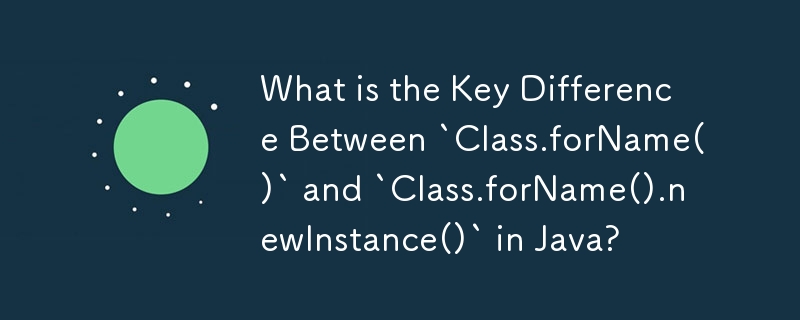Java 中 `Class.forName()` 和 `Class.forName().newInstance()` 之間的主要差異是什麼?

Understanding the Distinction Between "Class.forName()" and "Class.forName().newInstance()"
In Java, both Class.forName() and Class.forName().newInstance() play crucial roles in dynamic class loading. However, they serve distinct purposes.
Class.forName()
The Class.forName() method takes a fully qualified class name as a string and returns the Class object associated with that class. It does this by using the class loader to locate the class file and read its contents. Class.forName() does not instantiate the class. It simply provides access to its metadata and information.
Class.forName().newInstance()
The Class.forName().newInstance() method, on the other hand, creates a new instance of the class represented by the Class object returned by Class.forName(). It does this by invoking the class's default constructor.
Example:
Let's consider an example to illustrate the difference:
package test;
public class Demo {
public Demo() {
System.out.println("Hi!");
}
public static void main(String[] args) throws Exception {
Class clazz = Class.forName("test.Demo");
Demo demo = (Demo) clazz.newInstance();
}
}In this example:
- Class clazz = Class.forName("test.Demo"): This line loads the Demo class using Class.forName(). clazz now holds the Class object for the Demo class.
- Demo demo = (Demo) clazz.newInstance(): This line creates a new instance of the Demo class using Class.forName().newInstance(). The (Demo) cast is necessary because clazz.newInstance() returns an Object.
Key Difference:
The key difference between Class.forName() and Class.forName().newInstance() is that Class.forName() only loads the class, while Class.forName().newInstance() not only loads the class but also creates an instance of that class.
Dynamic Class Loading Use Cases:
Class.forName() and Class.forName().newInstance() are commonly used in scenarios where dynamic class loading is required. Examples include:
- JDBC drivers loading at runtime based on database requirements.
- EJB and Servlet containers dynamically loading and creating components.
- Plugins or extensions that are loaded on demand.
以上是Java 中 `Class.forName()` 和 `Class.forName().newInstance()` 之間的主要差異是什麼?的詳細內容。更多資訊請關注PHP中文網其他相關文章!

熱AI工具

Undresser.AI Undress
人工智慧驅動的應用程序,用於創建逼真的裸體照片

AI Clothes Remover
用於從照片中去除衣服的線上人工智慧工具。

Undress AI Tool
免費脫衣圖片

Clothoff.io
AI脫衣器

Video Face Swap
使用我們完全免費的人工智慧換臉工具,輕鬆在任何影片中換臉!

熱門文章

熱工具

記事本++7.3.1
好用且免費的程式碼編輯器

SublimeText3漢化版
中文版,非常好用

禪工作室 13.0.1
強大的PHP整合開發環境

Dreamweaver CS6
視覺化網頁開發工具

SublimeText3 Mac版
神級程式碼編輯軟體(SublimeText3)
 公司安全軟件導致應用無法運行?如何排查和解決?
Apr 19, 2025 pm 04:51 PM
公司安全軟件導致應用無法運行?如何排查和解決?
Apr 19, 2025 pm 04:51 PM
公司安全軟件導致部分應用無法正常運行的排查與解決方法許多公司為了保障內部網絡安全,會部署安全軟件。 ...
 如何將姓名轉換為數字以實現排序並保持群組中的一致性?
Apr 19, 2025 pm 11:30 PM
如何將姓名轉換為數字以實現排序並保持群組中的一致性?
Apr 19, 2025 pm 11:30 PM
將姓名轉換為數字以實現排序的解決方案在許多應用場景中,用戶可能需要在群組中進行排序,尤其是在一個用...
 如何使用MapStruct簡化系統對接中的字段映射問題?
Apr 19, 2025 pm 06:21 PM
如何使用MapStruct簡化系統對接中的字段映射問題?
Apr 19, 2025 pm 06:21 PM
系統對接中的字段映射處理在進行系統對接時,常常會遇到一個棘手的問題:如何將A系統的接口字段有效地映�...
 IntelliJ IDEA是如何在不輸出日誌的情況下識別Spring Boot項目的端口號的?
Apr 19, 2025 pm 11:45 PM
IntelliJ IDEA是如何在不輸出日誌的情況下識別Spring Boot項目的端口號的?
Apr 19, 2025 pm 11:45 PM
在使用IntelliJIDEAUltimate版本啟動Spring...
 如何優雅地獲取實體類變量名構建數據庫查詢條件?
Apr 19, 2025 pm 11:42 PM
如何優雅地獲取實體類變量名構建數據庫查詢條件?
Apr 19, 2025 pm 11:42 PM
在使用MyBatis-Plus或其他ORM框架進行數據庫操作時,經常需要根據實體類的屬性名構造查詢條件。如果每次都手動...
 Java對像如何安全地轉換為數組?
Apr 19, 2025 pm 11:33 PM
Java對像如何安全地轉換為數組?
Apr 19, 2025 pm 11:33 PM
Java對象與數組的轉換:深入探討強制類型轉換的風險與正確方法很多Java初學者會遇到將一個對象轉換成數組的�...
 如何利用Redis緩存方案高效實現產品排行榜列表的需求?
Apr 19, 2025 pm 11:36 PM
如何利用Redis緩存方案高效實現產品排行榜列表的需求?
Apr 19, 2025 pm 11:36 PM
Redis緩存方案如何實現產品排行榜列表的需求?在開發過程中,我們常常需要處理排行榜的需求,例如展示一個�...
 電商平台SKU和SPU數據庫設計:如何兼顧用戶自定義屬性和無屬性商品?
Apr 19, 2025 pm 11:27 PM
電商平台SKU和SPU數據庫設計:如何兼顧用戶自定義屬性和無屬性商品?
Apr 19, 2025 pm 11:27 PM
電商平台SKU和SPU表設計詳解本文將探討電商平台中SKU和SPU的數據庫設計問題,特別是如何處理用戶自定義銷售屬...






